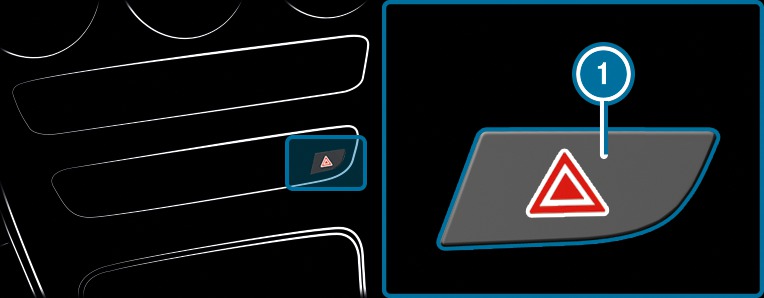
 .
. the airbag has been deployed.
the vehicle is heavily braked from a speed of more than 70 km/h to a standstill.
When you pull away again, the hazard warning light system will switch off automatically at approximately 10 km/h. You can also switch off the hazard warning light system using button  .
.
A fire extinguisher may impede pedal travel or block a depressed pedal.
This jeopardises the operating and road safety of the vehicle.
The fire extinguisher can be flung around and injure the driver or other vehicle occupants.

 upwards.
upwards.  downwards.
downwards.  .
. The safety vests are located in the stowage compartments in the driver's and front passenger door.
There are also safety vest compartments in the rear door stowage compartments in which safety vests can be stored.
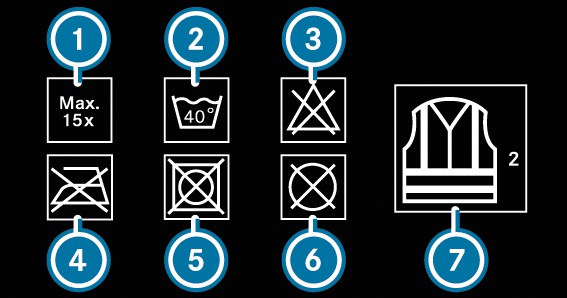







The requirements defined by the legal standard are only fulfilled if the safety vest is the correct size and is fully closed.
the reflective strips are damaged or dirty
the maximum permissible number of washes is exceeded
the fluorescence has faded
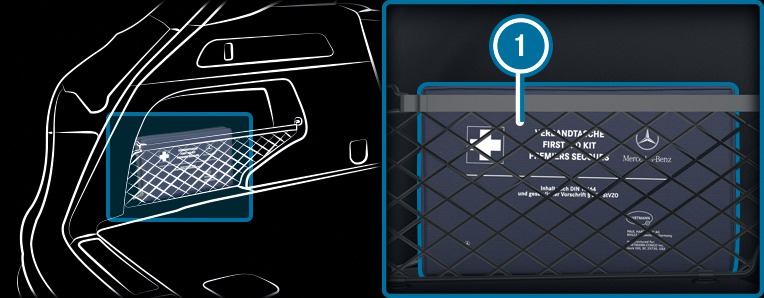
First-aid kit (soft sided)  is in the load compartment in the left-hand stowage net.
is in the load compartment in the left-hand stowage net.
QR codes are attached in the socket flap and on the opposite side on the B-pillar. In the event of an accident, rescue services can use the QR code to quickly find the appropriate rescue card for your vehicle. The current rescue card contains the most important information about your vehicle in a compact form, e.g. the routing of the electric lines.
Further information can be obtained at Mercedes-Benz homepage - rescue card.
If you manipulate or bridge a faulty fuse or if you replace it with a fuse with a higher amperage, the electric line could be overloaded.
This could result in a fire.
Electrical components or systems may be damaged by incorrect fuses, or their functionality may be significantly impaired.
Blown fuses must be replaced with fuses of the same rating, which you can recognise by the colour and the label. The fuse ratings and further information to be observed can be found in the fuse assignment diagram.
Fuse assignment diagram: on the fuse box in the load compartment More.
Moisture may cause damage to the electrical system or cause it to malfunction.
If the newly inserted fuse also blows, have the cause traced and rectified at a qualified specialist workshop.
The vehicle is secured against rolling away.
All electrical consumers are switched off.
The ignition is switched off.
A flat tyre affects the driving characteristics of the vehicle.
The emergency spare wheel is only available in certain countries.
Apart from some country-specific variants, vehicles are not equipped with a tyre-change tool kit. For more information on which tyre-changing tools are required and approved for performing a wheel change on your vehicle, consult a qualified specialist workshop.
Car jack
Chock
Wheel wrench
Centring pin
The jack weighs approximately 3.4 kg.
The maximum load capacity of the jack can be found on the sticker affixed to the jack.
The jack is maintenance-free. If there is a malfunction, please contact a qualified specialist workshop.
The tyre-change tool kit is located under the load compartment floor.
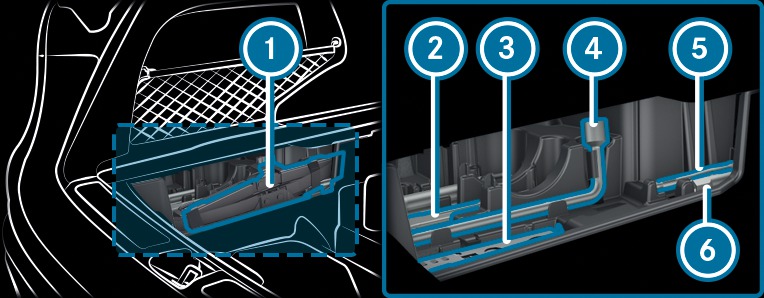






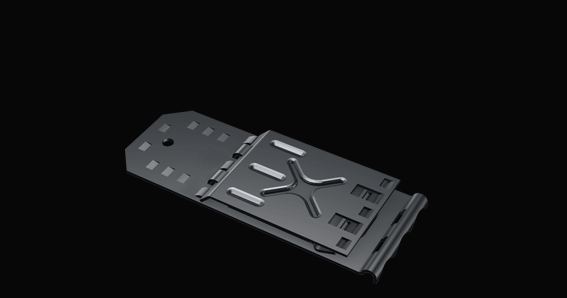
The TIREFIT kit is located under the load compartment floor.
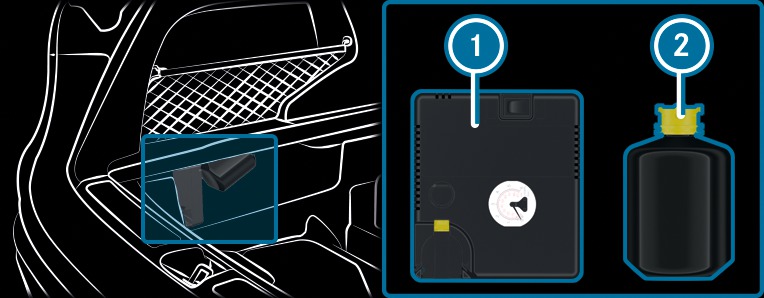


LK2 – 12 V/15 A, 180 W, 0.8 kg
Emission sound pressure level LPA 83 dB (A)
Sound power level LWA 91 dB (A)
The tyre inflation compressor is maintenance-free. If there is a malfunction, please contact a qualified specialist workshop.
the drive system cannot be started
the electric parking brake cannot be released or applied
the transmission cannot be shifted to position
 or
or 
if the transmission cannot be shifted to

if the 12 V battery is disconnected or discharged
if the multifunction display in the instrument cluster is not working
if the
 Towing not permitted See Owner's Manual message is displayed
Towing not permitted See Owner's Manual message is displayed if the
 Top up coolant See Owner’s Manual message is displayed
Top up coolant See Owner’s Manual message is displayed if the
 Stop Switch engine off message is displayed
Stop Switch engine off message is displayed
The drivetrain could be damaged when towing at excessively high speeds or over long distances.
The towing eye may become detached.
The vehicle/trailer combination may even tip over.
If a vehicle must be tow-started or towed away, its permissible gross mass must not exceed the permissible gross mass of the towing vehicle.
 .
.  .
. the ignition is switched off.
the brake system or power steering system is malfunctioning.
the energy supply or the on-board electrical system is malfunctioning.
the ignition is switched off.
the brake system or power steering system is malfunctioning.
the energy supply or the on-board electrical system is malfunctioning.
If you pull away sharply, the tractive power may be too high and the vehicles could be damaged.

